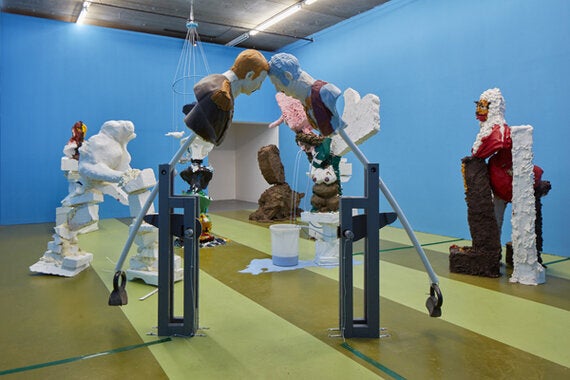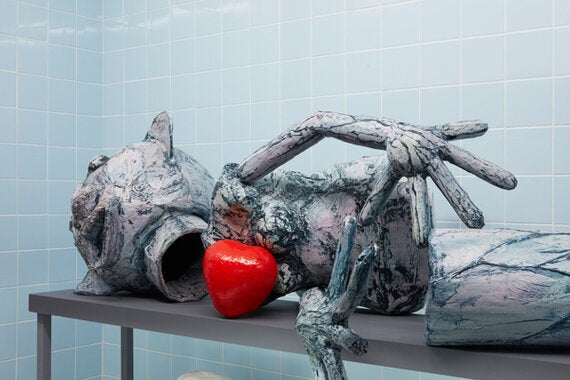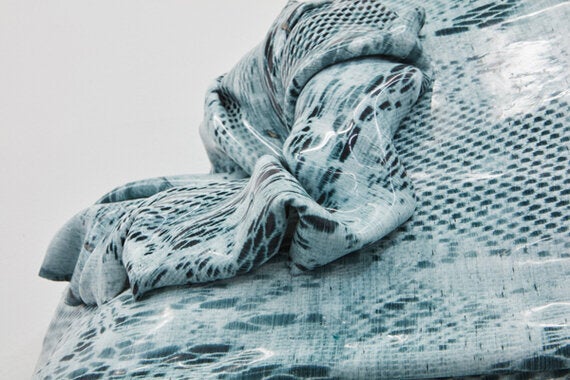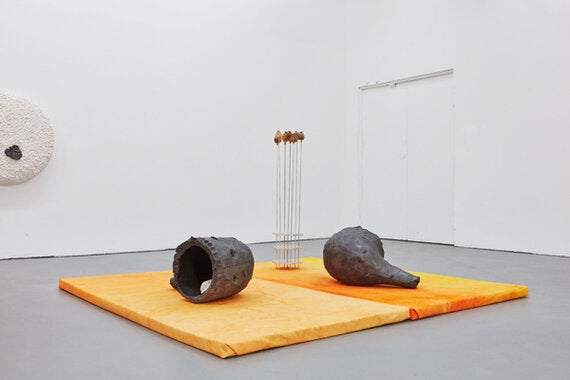"There's a perverse kind of theatricality about the work," says Justin Hammond, curator of the 2016 XL Catlin Art Prize exhibition, now in its 10th year. Seven of the most promising recently graduated artists, this year including PhDs, shortlisted from a pool of 30, have been commissioned for the show.

Nowhere is Hammond's description more apposite than in the work of Jamie Fitzpatrick (above) whose amusing mechanised sculptures resemble fairground caricatures that rhythmically move and clunk, even spewing out blue liquid. It's a critique on memorial statues that glorify individuals of a privileged social standing and asks if they are really that deserving. Since graduating from the Royal College of Art, Fitzpatrick has featured in several exhibitions including one at the Saatchi Gallery.
Another RCA graduate and as theatrical, though in a contrasting way, is Jude Crilly. She has taken a new Mercedes car in which two people sit. In a 14-minute immersive experience, the passengers listen to an audio sequence in which a rather frazzled EU commissioner is heard giving a ridiculous stream-of-consciousness rant. This involves environmentalism, hilarious dystopian speculations on the future and soft targets like Vegans to name but a few. For good measure, Crilly throws in throat singers to add to the ridiculousness. "It's not meant to be read as one narrative but a collage of many coming together and it gives this strange political view which, in the end, is not a political view," explains the artist. Crilly recently took part in the Transformation Marathon at the Serpentine Gallery and has a studio in Amsterdam.

Jane Hayes Greenwood, with an MA from City & Guilds of London Art School, has taken a piece of 3-D modelling software, called 123D, as her inspiration. The app requires taking photos of the subject from all angles, and the easiest way in which to experiment is to use your own body parts. The distorted images that result fascinate her. As well as painting such images in a kind of surreal collage, she has taken the idea further by creating a dismembered body in papier mache (above).
"Because I'd re-read Frankenstein about reassembling bodies and reanimating lifeless matter, I decided to construct my own body in this operating theatre setting," she tells me. Greenwood is very much involved with the Block 336 art collective in Brixton.
Christopher Gray's film, The Chamber, is not for the faint of heart. It's a graphic depiction of a medieval torture chamber in which a puppet version of the artist tortures and dismembers another puppet version of himself. Gray has modelled the victim using chicken skin from which he has cut away the flesh. He has then remodelled the carcass into the shape he wants, replaced the flesh and then stitched the skin back on so that when it is stabbed, blood pours out. It's a critique on violence as a form of entertainment and the film evokes feelings of repulsion and curiosity, rather like the sport of boxing of which Gray, a graduate of Goldsmiths College, was once a practitioner.

The work above may look like a piece of cloth but it is, in fact, made of silicone. It's the work of sculptor Neal Rock, who has gained a PhD from the Royal College of Art. Silicone is a substance normally associated with everything from sex toys to prosthetic limbs. The work here has been pigmented with the pattern of lace. The silicone is stretched over polystyrene armatures, the malleable contrasting with the rigid. "Silicone is a fairly fetishistic material in a way," says Rock. "It's there but you don't often see it or know it's there." Rock divides his time between London and Los Angeles, and has taken a painting fellowship at the University of Iowa.

Hamish Pearch, from Camberwell College of Arts, collects clay pipes (above) that trigger a narrative and deal with male-dominated leisure activities like pipe smoking. He has a fascination too with objects associated with WWF wrestling and with the personas that both the wrestlers and their fans adopt. He has featured in many shows since graduating and was awarded a solo exhibition by Light Eye Mind for winning its Graduate Award.

Rory Biddulph's paintings (as above) feature scary looking humanoids with mask-like faces that have no eyes. Masks are often used as symbols of something to hide and Biddulph's are painted in a carnivalesque way, grotesque and distorted. "They have no eyes because eyes can represent something human and I wanted to leave humanity out, just raw power," Biddulph explains. His work references iconography, ideology and spectacle as well as theatricality. He is also interested in layers of meaning The fellow in the right-hand picture is clutching something red that could be a Pandora's box or a Chancellor's brief-case. There's a vulnerability there - whatever it is, he certainly wants to keep hold of it. Biddulph has an MA from the Slade School of Art and has exhibited in several London exhibitions since graduating.
The theatrical aspect of the works Justin Hammond has curated here give the exhibition a more cohesive flow than those I've been to in the past. More care has been taken to ensure that concepts dovetail, and the exhibits are more accessible than some in previous years. The Prize exhibits are a useful indicator for the direction in which young artists are thinking today.
The XL Catlin Prize 2016 exhibition is showing at the Londonewcastle Project Space, 28 Redchurch Street, London E2 7DP until 22 May. On 17 May, a panel of judges will pick the winner who will receive £5,000. Visitors can ballot for their own favourite for which there'll be a £2,000 prize.
The images are courtesy of Tom Carter and used with the permission of the artists.